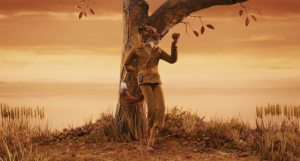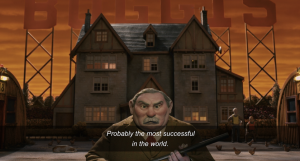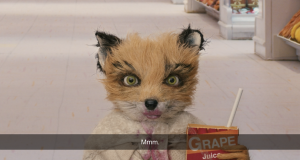33
Difference, Power, and Discrimination in Fantastic Mr. Fox
By Nadia Bodner
Addressing issues of difference, power, and discrimination (DPD) has long been sought after in America since the birth of the nation. In fact, it was because of the tyranny from England that America became its own nation. So, America has seen a long plight for rights and representation ingrained in its culture, and film no less; as since the creation of film, people have been given the ability to capture and present many key aspects of social topics including race, class, gender, and sexuality. The film Fantastic Mr. Fox by Wes Anderson is a great example of these representations captured on film.
The film version of Fantastic Mr. Fox that came out in 2009, is an adaptation of the classic tale written by distinguished author Roald Dahl who is known for creating children’s stories that explore unconventional issues below the surface. “Fantastic Mr Fox was first published in 1970, a different age, and it is tellingly old-fashioned in its treatment of gender and body-image,” and therefore the film adaptation follows suit, giving it a more “old fashioned” outlook on social issues compared to today’s standards (Manley-Hadley). The basic plot of the film follows a cartoonishly anthropomorphic fox deemed “fantastic Mr. Fox” as he reverts back to his crime-ridden days of stealing from wealthy farmers after keeping a promise to his wife for 12 years that he would give up crime in order to pursue a safe and steady family lifestyle as per the “American dream.” As in this film, all of the animals lead very human-like lives alongside the humans of the film. The turn of events in Mr. Fox’s lifestyle ultimately leads to misfortune and the downfall of not only Mr. Fox and his family, but the destruction of his town; that is, until the end of the film where everyone lives happily ever after, since this is a children’s movie after all.

Since the majority of the characters in the film are animals, the topic of race is represented in a slightly different fashion when it comes to the animals. One way, in particular, is how the predators tend to be at the top of the food chain not only in the literal sense but in a business sense as well. The badger and beaver are successful businessmen, the weasel is a real estate agent, and the possum is merely a handyman as from a human’s perspective, many people often find possums to be squalid in nature. Another interesting point about the difference in race between the animals are the stereotypes about the nature of each animal, as Mr. Fox says himself that “a fox ought to have a chicken in its mouth,” implying that foxes should be cunning, wild hunters. The animal presented to be highest in the pecking order of the film, aside from the humans, is the wolf. His presence is ominous and threatening, even to the fantastic Mr. Fox who braves many challenges throughout the film. Though, one thing I would like to note about the humans in the film is that they are all white. This could be in part to the film taking place in a small suburban farming town in America in the 70s, though this lack of representation when it comes to race is less common in more modern American films.
White patriarchal capitalism still tends to reign supreme in even modern America, and it is no different in the film industry, with Fantastic Mr. Fox included. The most successful people in the film are the three human farmers Boggis, Bunce, and Beans. Mr. Fox’s lawyer, the badger, describes Boggis as “a chicken farmer, probably the most successful in the world.” While Bunce is a duck and goose farmer and Beans is a chicken and apple farmer known for his alcoholic apple cider. All three farmers are rich, white, American men, who even by today’s society are still known to be at the top of the socioeconomic pecking order in America.

As the title of the film implies, the title of being fantastic Mr. Fox as opposed to just Mr. Fox is one that comes with great duty. Many of the characteristics that Mr. Fox feels makes him so great are tied to his masculinity, especially since this film takes place during the 70s when men were taught they ought to be the strong and capable breadwinners of the family. Mr. Fox in his youth was a great whack bat (a made-up sport akin to baseball) player and grows up to become a successful husband and father. The reason behind Mr. Fox’s downfall in the middle of the film is due to the fact that he does not feel that he has not accomplished enough as a man, despite his wife stating that they were “poor but happy.” This crisis of self is what prompts him to buy and renovate a nicer and newer house and revert back to his criminal ways in order to put better food on the table. Though it is not until the end of the film that he realizes that his pride had gotten in the way, and put those that he loved most, in danger, which ends up being the culmination of the moral of the story, to not let your pride get in the way of those you love most.
(Screenshot from Fantastic Mr. Fox, 00:05:56)
Until recent years in America, after the gay rights movement and the legalization of gay marriage in 2015, open discussion of being anything but heterosexual were few and far between. This is seen throughout this film in particular as we see Mr. Fox’s son Ash be considered “different,” despite his attempts to be athletic like his father. One film analysis site describes Ash as being “ambiguously gay” as he “dresses like a girl according to Beaver’s son, and is extremely fussy… and he’s seen with markings that resemble eyeliner. Not to mention the grape juice “lipstick” he sports near the end of the film.” (TV Tropes) The site also acknowledges how whenever a character in the film is pointed out for being “different” by another character, they use a kind of finger-wiggling hand motion to possibly hint at something other than heterosexuality. One bully in the film also calls Ash a wet sandwich and says that he dresses like a girl, which is something stereotypically associated with being gay. Another character marked by the implications of being something other than heterosexual is the realtor, a weasle. He, unlike the other males prevalent in the film, walks in an effeminate way and is seen sporting a pink polo shirt. This contrast in style and costume could, but not necessarily, imply that he may be gay.

As for the women in the film, they adhere to the common stereotypes surrounding women in the 70s, typically being housewives and taking care of the children. Analysis of one laundry ad from the 70s commented how women were often “infantilized” at home and that “marriage was considered a woman’s ticket to happiness and those big-ticket items: house, children, gleaming washer-dryer,” further insinuating how a woman’s place was at home and her duty was to support the man starring in her life (Lippert). This film, much like many other films in the industry, stars a male as the main character with the women merely serving as a romantic interest for the lead male. This trope was especially prevalent in films of this era as during the 70s it was expected that once women were properly wed, they would take care of the children, cooking, and cleaning, only to “ sit and wait patiently for their husbands to return home to them.” (Benshoff) The one and only human female of the film is the wife of Beans, who is only briefly seen on screen getting her husband alcohol from the cellar and preparing dinner for their son. As for the female animals in the film, most notably Ms. Fox, her greatest contribution to the plot is influencing Mr. Fox to better assess the impact of his recklessness. At one of the highest points of the film for the animals, after they successfully infiltrate the 3 farmers’ stores of poultry and alcohol, we see the women in the kitchen preparing the feast while the men talk amongst each other with glasses of alcohol in hand. Yet another implication of the stereotype of a “proper woman” that was commonly held during the 1970s.
As you can see, the film Fantastic Mr. Fox stands as a shining representation of commonly held conceptions of sociocultural and DPD issues including race, class, gender, and sexuality. Since the film takes place during the 70s, these topics are presented in a more discriminatory light in comparison to modern standards in America where equality and social justice are more openly sought after. Many Americans still face DPD issues including but not limited to the racism, sexism, and classism seen in Fantastic Mr. Fox. The film industry is just one aspect of America’s culture that is still ridden with discrimination and lack of representation, and it is our duty to strive towards a future with greater opportunity for all.
REFERENCES
Benshoff, Harry M., and Sean Griffin. America on Film: Representing Race, Class, Gender, and Sexuality at the Movies, John Wiley & Sons, Incorporated, 2009. ProQuest Ebook Central, http://ebookcentral.proquest.com/lib/linnbenton-ebooks/detail.action?docID=819377.
Lippert, Barbara. “THE REAL HOUSEWIVES OF THE 1970S: GRAB ‘EM BY THE COLLAR.” Linnbenton.edu, 2017, eds.a.ebscohost.com.ezproxy.libweb.linnbenton.edu:2048/eds/detail/detail?vid=0&sid=b0991a56-b0e9-4770-b577-af6a2a4708a3%40sdc-v-sessmgr02&bdata=JnNpdGU9ZWRzLWxpdmU%3d#AN=edsbig.A513950098&db=edsbig.
Manley-Hadley, Scott. “Fantastic Mr Fox by Roald Dahl.” Triumph Of The Now, 29 Sept. 2018, triumphofthenow.com/2016/09/17/fantastic-mr-fox-by-roald-dahl/.
“Fantastic Mr. Fox.” TV Tropes, tvtropes.org/pmwiki/pmwiki.php/WesternAnimation/FantasticMrFox.

